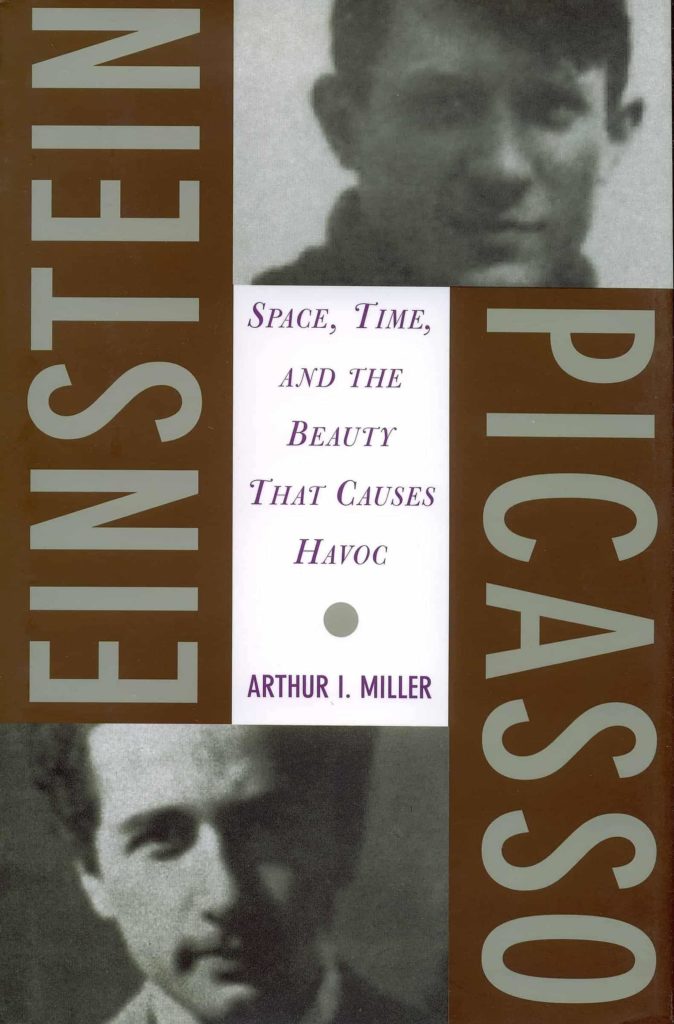
The most important scientist of the twentieth century – Albert Einstein – and its most important artist- Pablo Picasso – went through their period of greatest creativity almost simultaneously and in remarkably similar circumstances. This parallel biography of Einstein and Picasso as young men focuses on their greatest achievements: Einstein’s special theory of relativity and Picasso’s Les Demoiselles d’Avignon, the painting that brought art into the twentieth century. When they produced these astonishing breakthroughs, Einstein and Picasso were in their twenties, unknown, feisty, dirt-poor, and prone to getting into trouble. For a while, Picasso even carried the playwright Alfred Jarrey’s pistol – loaded with blanks – with which he would shoot people who struck him as overly dull or earnest.
Einstein, Picasso is filled with revelations about how these young geniuses lived and worked. Picasso’s discovery of cubism, while firmly grounded in artistic tradition, also partook liberally of the artist’s everyday life and the intellectual milieu of turn-of-the-century Paris. The influences of photography, cinema, the cutting-edge science of the day, and the ideas of the philosopher-scientist Henri Poincaré all make their appearance in Les Demoiselles. Einstein, having so alienated his college teachers that none would recommend him for a university position, was forced to take a job in the Swiss Federal Patent Office. There he found himself immersed in technological problems. Two of these problems, having to do with the design of electrical dynamos and the coordination of train schedules, played pivotal roles in the discovery of relativity. This book reveals the unifying threads that tie together two most original minds of the twentieth century. Einstein and Picasso came of age at the exact moment in history when it was first becoming apparent that classical, intuitive ways of understanding space and time were not adequate. Each in his own way – Einstein with relativity and Picasso with cubism – was striving for a deeper, more satisfying way to represent space and time. In the most important sense, they were both working on the same problem.
Nominated for the Pulitzer Prize.
Reviews
‘Learned, inspired and daring … a fine and stimulating book. It makes breath-taking connections across the so-called two cultures of science and art, identifies the mysterious synchronous effects of the Zeitgeist, places aesthetics firmly at the heart not only of art but of science as well, and, not least, celebrates the excitement and the glories available, even yet, to the life of the mind.’
John Banville, The Irish Times
‘An exciting book… Perhaps the best fun is to see Miller shape his speciality subject, relativity, into language accessible to readers interested in both Einstein and Picasso… Miller is an excellent historian – exhaustive in searching for sources and savvy in deciding what weight to give each one – and a fine biographer, with a keen eye for the details of a life… His fine sense of narrative lets his book assume its natural structure as a double detective story… an intellectual thriller.’
William R. Everdell, The New York Times
‘A lively and compelling narrative. It captures what Miller clearly feels to be the sheer, exhilarating excitement of those times, places and events… a valuable nugget of historical research.’
Nature
‘Einstein, Picasso presents new insights into the creative processes common to a revolutionary scientist and radical artist.’
New Scientist
‘A brilliant book… offers the best explanation I have seen for the apparently independent discoveries of cubism and relativity as parts of a larger cultural transformation… Miller provides fascinating biographies of both men… I strongly recommend this book to anyone interested in physics or art: it enhances a reader’s understanding of the connections between art and science. It also underscores the breadth and pervasiveness of an epoch’s intellectual ferment.’
Stephen G. Brush, Physics Today
‘Eloquent and wide-ranging.’
Publishers Weekly
‘Many have sensed links between Einstein and Picasso, but few have the knowledge to probe their affinities deeply. Arthur Miller has written a fascinating and illuminating book.’
Howard Gardner, author of Creating Minds.
‘Einstein, Picasso’ meeting – Dortmund, Germany, March 2009
In March 2009 the British Council convened a meeting in Dortmund, Germany, exploring creativity in art and science, directly inspired by my book Einstein, Picasso.
‘Albert Einstein, the most important scientist of the 20th century, and Pablo Picasso, its most important artist, were both – in their own way – striving for a new and profound way to represent the universe’s geometry. Einstein came up with the theory of relativity, Picasso with cubism when exploring the same problem: How to represent space and time at just the moment in history when it became apparent that these entities are not what we intuitively perceive them to be. This parallel of problem-solving and creative approach in science and art was of interest to Arthur I. Miller, Professor Emeritus of History and Philosophy of Science at University College London when writing “Einstein, Picasso – Space, Time, and the Beauty that Causes Havoc” (2001).’
British Council, Deutschland